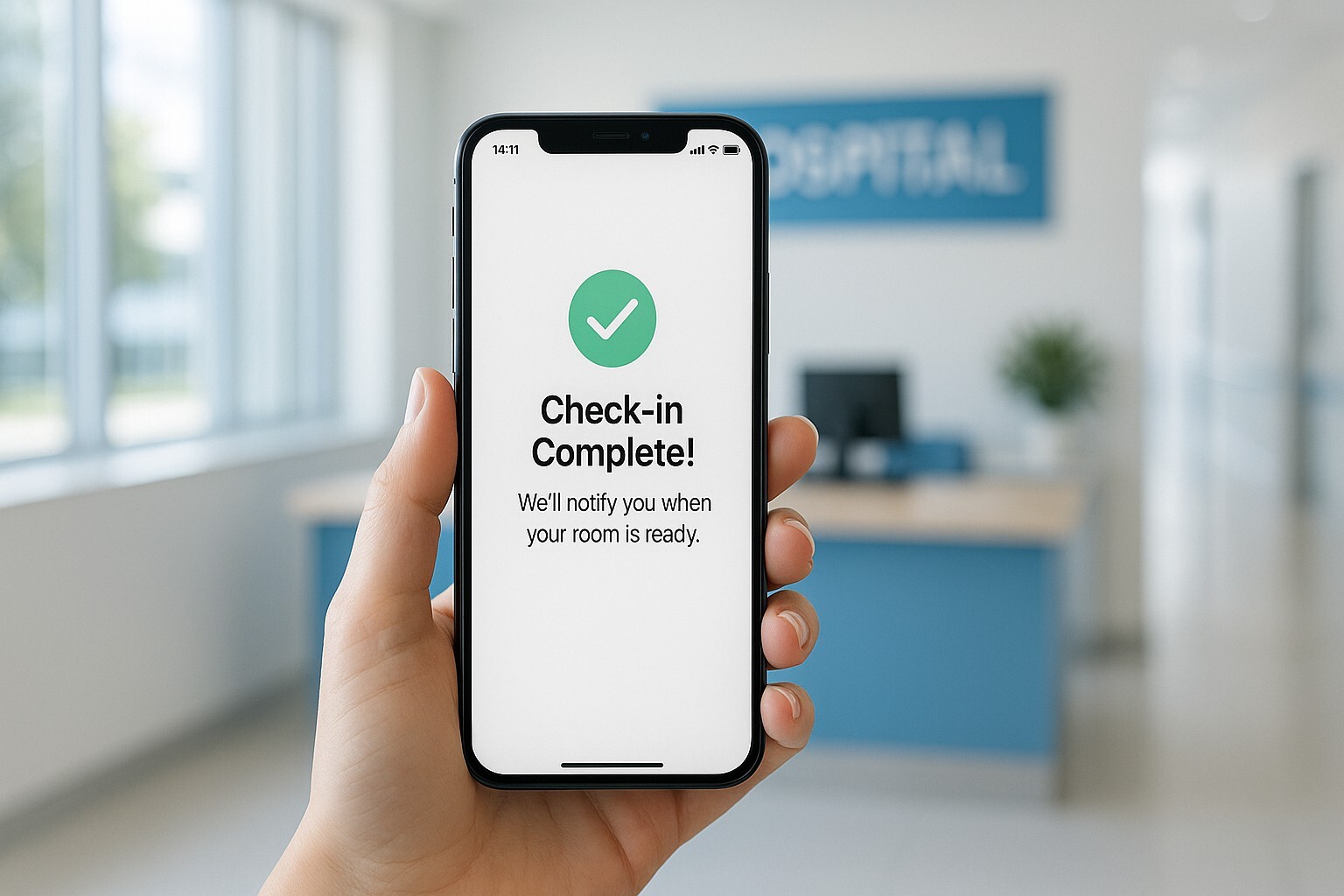The Ultimate Guide to Contactless Patient Check-in and Contactless Hospital Check-in
A contactless patient check-in system allows patients to complete registration, forms, and payments from their own device before arriving,...
8 min read
Alvin Amoroso : 7/31/25 8:17 AM

The single biggest opportunity to reduce staff workload and improve patient satisfaction lies in the first five minutes of a patient's visit. A modern patient check in system is a powerful software platform that automates the entire patient arrival and intake process, transforming a traditionally slow and error-prone workflow into a fast, seamless digital experience. By eliminating clipboards, manual data entry, and front-desk bottlenecks, these systems are essential for any medical practice looking to thrive in 2025.
But with dozens of options on the market, choosing the right patient check in software can be overwhelming. The best solution for a large hospital system is often different from the needs of a small independent practice or a specialized clinic. To help you navigate this critical decision, we’ve researched, reviewed, and ranked the top 10 patient check-in systems available today. We evaluated them based on their core features, user experience, integration capabilities, and overall value, with a clear winner emerging for its comprehensive, all-in-one approach.
Curogram stands out from the competition by being far more than just a check-in tool; it’s a complete patient engagement and communication platform. While its check-in features are best-in-class, its true power lies in its ability to manage the entire patient journey through a single, easy-to-use interface that prioritizes two-way communication. This makes it the undisputed top choice for practices seeking a comprehensive, all-in-one patient check in system.
The platform is built around a universal inbox that consolidates all patient communications—including secure two-way SMS texting, appointment reminders, and broadcast messages. The digital check-in process is seamless. Patients receive a link via text, allowing them to complete all forms, upload insurance cards, and make payments from their own phone before they even arrive. This pre-visit workflow dramatically reduces waiting room time and eliminates nearly all manual data entry for staff.
Key Features:
Why it’s #1: Curogram is the best patient check in software because it solves the biggest problems in a practice—communication and workflow inefficiency—with a single, elegant solution. It replaces the need for multiple single-purpose vendors (one for reminders, one for forms, one for telemedicine) with one platform that does it all, delivering an exceptional return on investment and a superior experience for both patients and staff.
Phreesia is a giant in the patient intake space and is widely recognized as a market leader, particularly among enterprise-level clients like large multi-specialty groups and hospital systems. Its platform is incredibly robust, with a heavy focus on automating the financial aspects of a patient’s visit.
Phreesia’s core strength is its powerful rules-based engine for insurance verification and payment collection. It can automatically check eligibility, estimate patient responsibility, and prompt for payment at the time of check-in, whether on a mobile device or one of their proprietary PhreesiaPads. This focus on the revenue cycle makes it a powerful tool for organizations looking to optimize financial performance.
Key Features:
Best For: Large health systems and hospitals that need a powerful, scalable intake solution with deep revenue cycle management capabilities.
SimplePractice has carved out a dominant niche by creating an all-in-one practice management solution tailored specifically for therapists, psychologists, and other behavioral health practitioners. While it serves a broader wellness market, its feature set is perfect for solo and small group therapy practices.
The patient check in system within SimplePractice is part of a larger, integrated workflow that includes scheduling, billing, and a secure client portal. Therapists can send new clients a link to the portal where they can fill out intake forms, consent documents, and enter payment information before their first session. It’s incredibly streamlined for the specific needs of mental health professionals.
Key Features:
Best For: Solo and small group practices in the mental health and wellness fields.
athenahealth is one of the largest EHR providers in the country, and its patient check in software capabilities are a core component of its athenaCollector and athenaClinicals suites. For practices already using or considering the athenahealth ecosystem, its check-in tools offer the tightest possible integration.
Patients can pre-register through a patient portal, and the athenahealth platform offers kiosk-based check-in at the clinic. Because it's part of the same system that manages scheduling, billing, and the clinical record, data flows seamlessly throughout the patient journey without the need for complex third-party integrations.
Key Features:
Best For: Medical practices of all sizes that are committed to the athenahealth ecosystem and prioritize native integration above all else.
Mend is a patient engagement and telehealth platform that builds its intake and check-in process around the unique needs of virtual care. While it serves in-person clinics as well, its digital-first approach makes it a strong contender for practices with a significant telehealth component.
Mend’s workflow is designed to ensure the patient is fully prepared for their virtual visit. The system automates reminders and provides patients with a simple, one-click link to join their session. Before connecting, it guides them through a process of completing digital forms, verifying information, and making payments, ensuring the provider has everything they need for an efficient virtual consultation.
Key Features:
Best For: Practices and organizations that have a "telehealth-first" or hybrid care delivery model.
Solutionreach has been a leader in patient relationship management (PRM) for years. While its platform is broad, its patient intake and check-in features are a core part of its mission to manage the entire patient journey.
The system focuses on clear communication, sending automated appointment reminders that allow patients to confirm and begin the check-in process directly from a text or email. It pushes digital forms to patients ahead of time, which are then synced back to the practice’s PM/EHR system. Solutionreach also excels at post-visit communication, like surveys and recall reminders.
Key Features:
Best For: Practices that want to pair their check-in process with a robust, long-term patient communication and retention strategy.
Tebra is the new company formed by the merger of Kareo and PatientPop. Kareo was well-known for its clinical and financial software for independent practices, while PatientPop focused on practice growth and marketing. Tebra combines these into a single platform, and its patient check in system is part of this "all-in-one" offering.
The check-in solution allows for digital intake and online registration, designed to be easy to use for smaller practices without dedicated IT teams. It integrates directly with the Kareo Clinical EHR and Kareo Billing modules, creating a unified workflow from patient acquisition to payment posting.
Key Features:
Best For: Small to medium-sized independent practices looking for a single vendor to handle their clinical, financial, and marketing needs.
AdvancedMD offers a comprehensive, cloud-based suite of software for physicians, with strong offerings for high-volume specialty practices. Its patient intake and check-in solution is designed for speed and efficiency to keep busy clinics on schedule.
The platform offers customizable intake forms that can be tailored to the specific needs of different medical specialties. Patients can complete these forms online ahead of time. For in-office check-in, the system supports both staff-driven and kiosk-based workflows, all of which are fully integrated with the AdvancedMD EHR and practice management software.
Key Features:
Best For: Independent specialty practices (e.g., orthopedics, cardiology, dermatology) that need a robust, unified software suite.
DrChrono was one of the first EHRs built from the ground up for the Apple iPad and iPhone, and this mobile-first philosophy extends to its patient check in system. The platform is ideal for providers who want the flexibility to manage their practice from a tablet.
Patients can check in via an iPad kiosk in the waiting room or on their own iPhone. The platform allows for the customization of medical forms, and patients can sign consents directly on the screen. The seamless integration between the check-in app and the EHR app makes for a very modern, streamlined clinical experience.
Key Features:
Best For: Tech-savvy providers and practices that prefer to operate primarily on mobile Apple devices.
Nextech is another EHR and practice management vendor that focuses deeply on the needs of specific medical specialties, particularly ophthalmology, dermatology, and plastic surgery. Its patient intake solution is designed to handle the unique and complex data requirements of these fields.
The platform’s check-in features are integrated into its patient portal, allowing patients to update detailed clinical histories, sign specific consent forms (e.g., for surgical procedures), and review educational materials before their appointment. This specialty-specific approach ensures that all necessary data is captured efficiently.
Key Features:
Best For: Specialty practices in ophthalmology, dermatology, and plastic surgery that require a highly tailored software solution.
Simply picking a name from a list isn't enough. To find the best patient check in system for your unique needs, follow these critical steps:
The patient check-in process is the series of steps a patient takes upon arriving for a medical appointment. Traditionally, this involves signing in at the front desk, filling out paper forms, providing an insurance card and ID, and making a copayment. A modern process digitizes these steps, often allowing patients to complete them online before the visit or through a self-service kiosk at the clinic to improve efficiency and reduce wait times.
A patient self check-in system is a technology, typically involving a software application on a kiosk, tablet, or a patient's own smartphone, that allows them to register for their appointment without assistance from front desk staff. Using this system, patients can verify their identity, update personal and insurance information, answer medical questions, sign consent forms, and pay their bills independently.
While requirements can vary, three fundamental things needed from a patient checking into a hospital or clinic are:
To improve patient check-in, practices can:

A contactless patient check-in system allows patients to complete registration, forms, and payments from their own device before arriving,...

The modern patient expects convenience, speed, and digital-first experiences in every aspect of their lives—including their healthcare. A digital...

The first few minutes a patient spends interacting with your practice can define their entire experience. A clunky, slow, and confusing medical check...